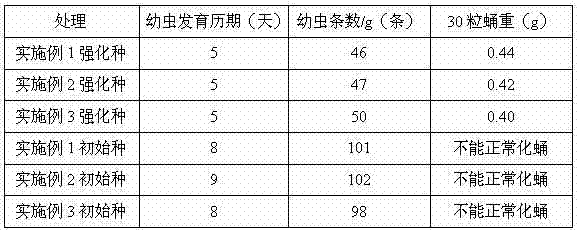Reinforcing method for nicotine-resistant housefly species
A nicotine-resistant and housefly-resistant technology, applied in applications, animal feed, animal feed, etc., can solve the problem of lack of nicotine-resistant housefly species, and achieve the effect of improving tolerance and enhancing tolerance
- Summary
- Abstract
- Description
- Claims
- Application Information
AI Technical Summary
Benefits of technology
Problems solved by technology
Method used
Image
Examples
Embodiment 1
[0029] One, at first, screen out the nicotine-resistant housefly variety from the wild housefly variety, the specific method is as follows:
[0030] S1. When the weather is fine, prepare a trapping compost, which contains the following components in weight percentages: 30% unsuitable fresh tobacco leaves, 60% bran, 5% imported fish meal, and 5% soybean meal. Adjust the humidity of the compost to about 65% by adding a certain amount of water.
[0031] S2. Put the prepared culture material above into a square plastic pot per 1 kg (length*width*height=45cm*30cm*12cm). At 8:00 in the morning on the same day, the plastic pots containing the culture material were placed next to a domestic garbage dump, and at 17:00 in the afternoon, the plastic pots were taken back and brought back to the indoor cultivation.
[0032] S3. Under indoor conditions (temperature 25°C, humidity 30%), cultivate the trapped wild fly eggs until the larvae are mature, spread the culture material on a 10-20 m...
Embodiment 2
[0045]One, at first, screen out the nicotine-resistant housefly variety from the wild housefly variety, the specific method is as follows:
[0046] S1. When the weather is fine, prepare a trapping compost, which contains the following components in weight percentages: 40% unsuitable fresh tobacco leaves, 50% bran, and 10% imported fish meal. Adjust the humidity of the formula to about 65% by adding a certain amount of water.
[0047] S2. Put the prepared culture material above into a square plastic basin (length*width*height=45cm*30cm*12cm) every 1.2 kg. At 8:00 in the morning on the same day, the plastic pots with compost were placed in a chicken farm, and at 17:00 in the afternoon, the plastic pots were taken back and brought back to the indoor cultivation.
[0048] S3. Under indoor conditions (temperature 28°C, humidity 40%), cultivate the trapped wild fly eggs until the larvae are mature, spread the culture material on a 10-20 mesh screen, and place the screen in the sun ...
Embodiment 3
[0060] One, at first, screen out the nicotine-resistant housefly variety from the wild housefly variety, the specific method is as follows:
[0061] S1. When the weather is fine, prepare the trapping compost, which contains the following components in weight percentages: 50% of unsuitable fresh tobacco leaves; 40% of bran; 10% of soybean meal. Adjust the humidity of the formula to about 65% by adding a certain amount of tap water.
[0062] S2. Put the prepared culture material above into a square plastic basin (length*width*height=45cm*30cm*12cm) every 1.5 kg. At 8:00 in the morning on the same day, the plastic pots with culture materials were placed in a pig farm, and at 17:00 in the afternoon, the plastic pots were taken back and brought back to the indoor cultivation.
[0063] S3. Under indoor conditions (temperature 30°C, humidity 60%), cultivate the trapped wild fly eggs until the larvae are mature, spread the culture material on a 10-20 mesh screen, and place the sc...
PUM
 Login to View More
Login to View More Abstract
Description
Claims
Application Information
 Login to View More
Login to View More - R&D
- Intellectual Property
- Life Sciences
- Materials
- Tech Scout
- Unparalleled Data Quality
- Higher Quality Content
- 60% Fewer Hallucinations
Browse by: Latest US Patents, China's latest patents, Technical Efficacy Thesaurus, Application Domain, Technology Topic, Popular Technical Reports.
© 2025 PatSnap. All rights reserved.Legal|Privacy policy|Modern Slavery Act Transparency Statement|Sitemap|About US| Contact US: help@patsnap.com

